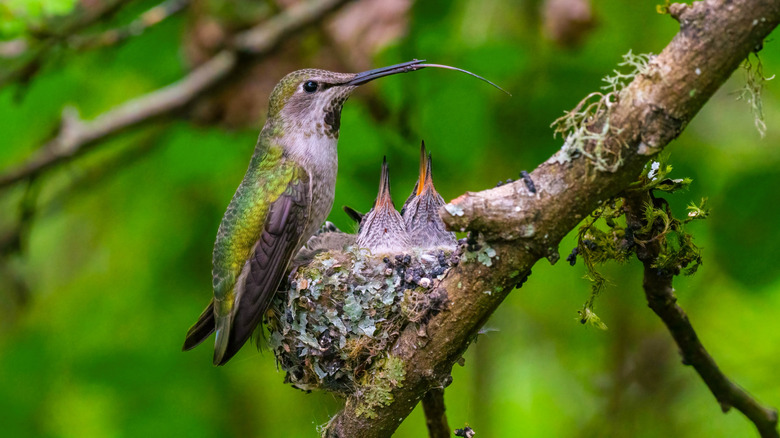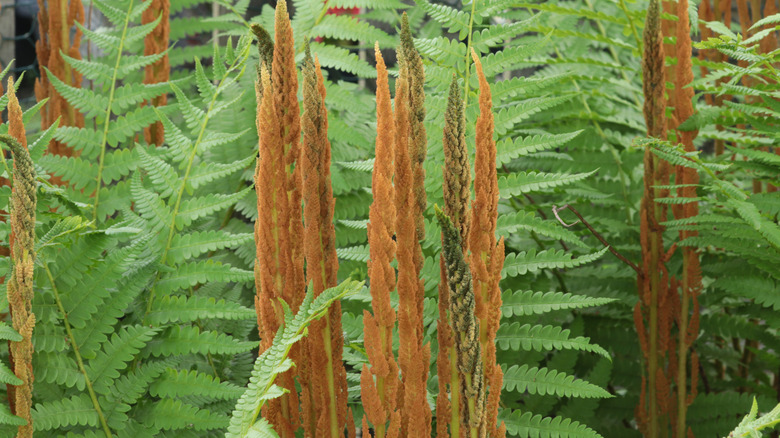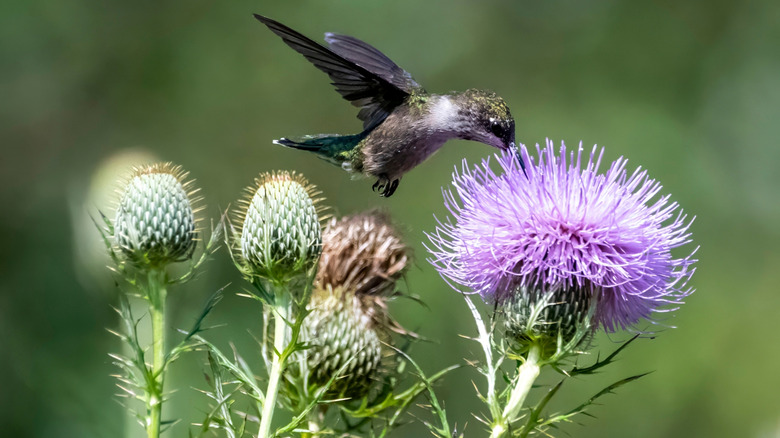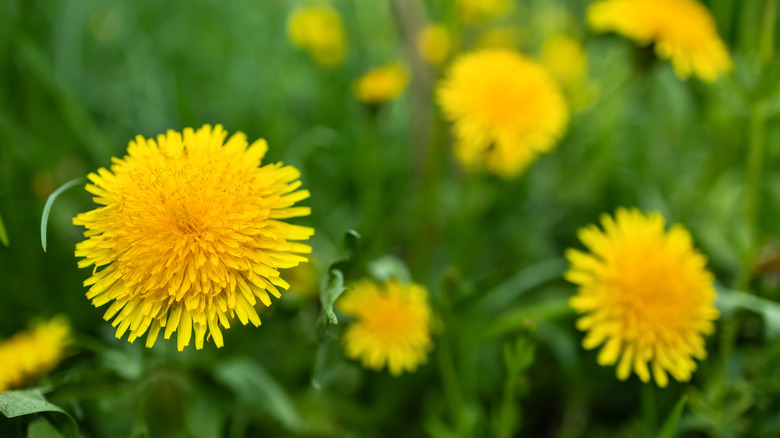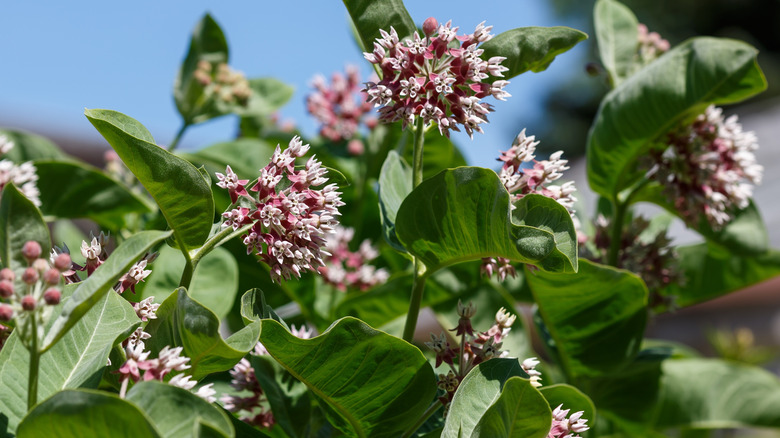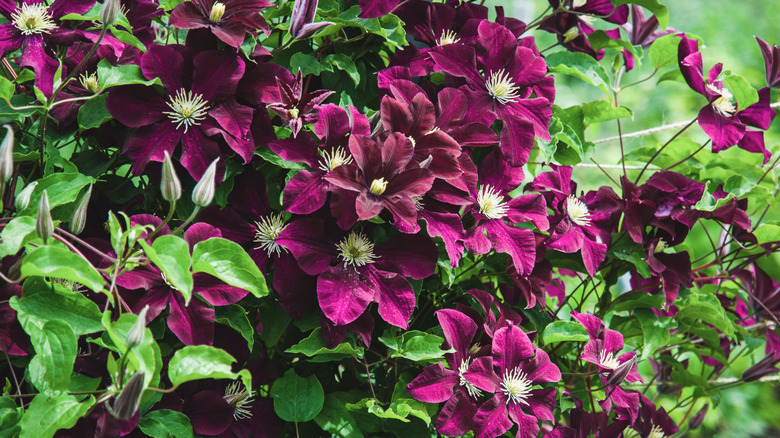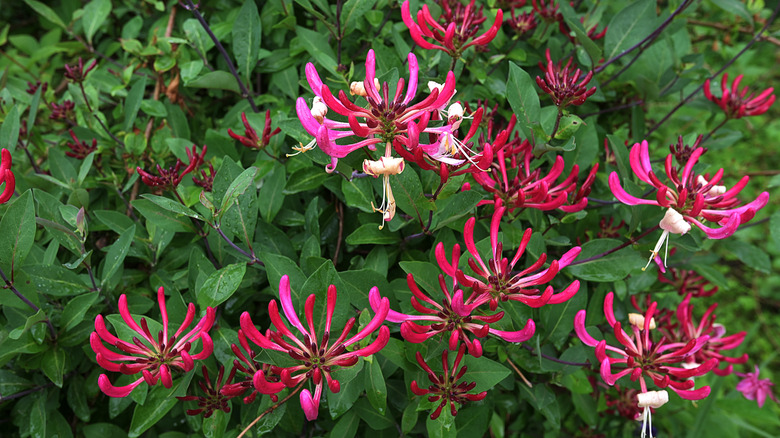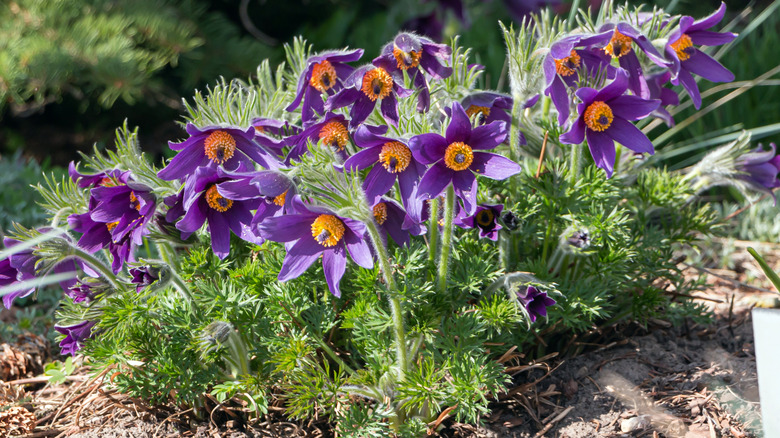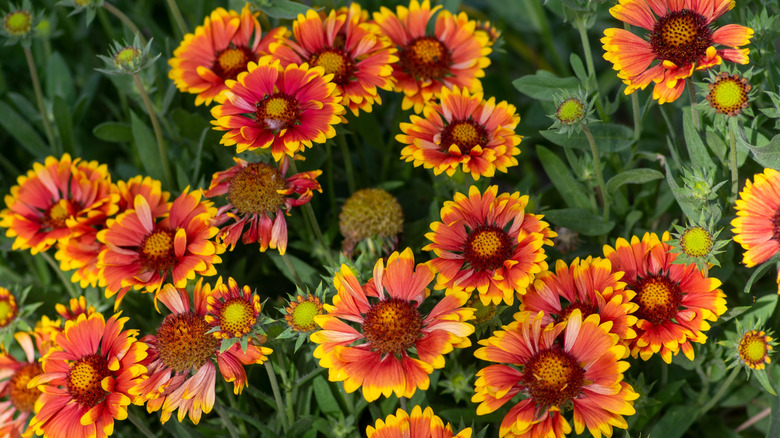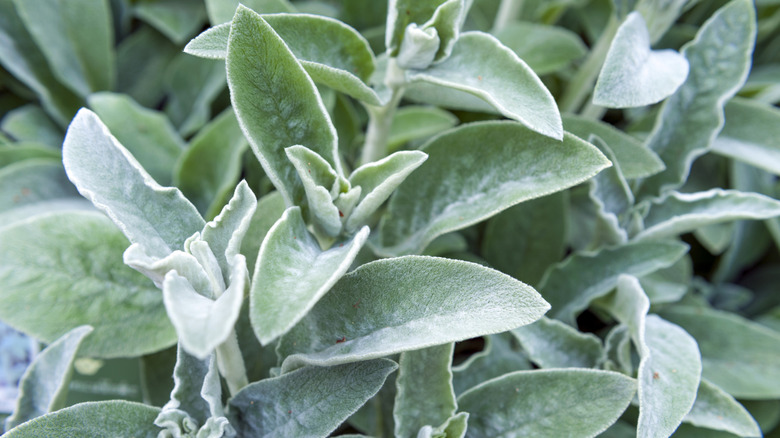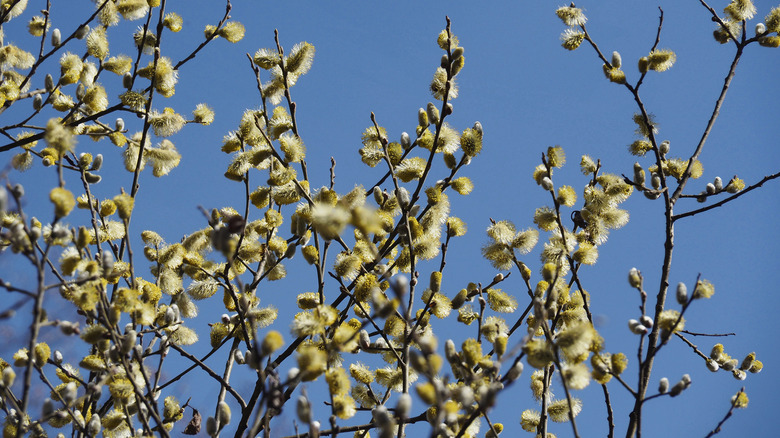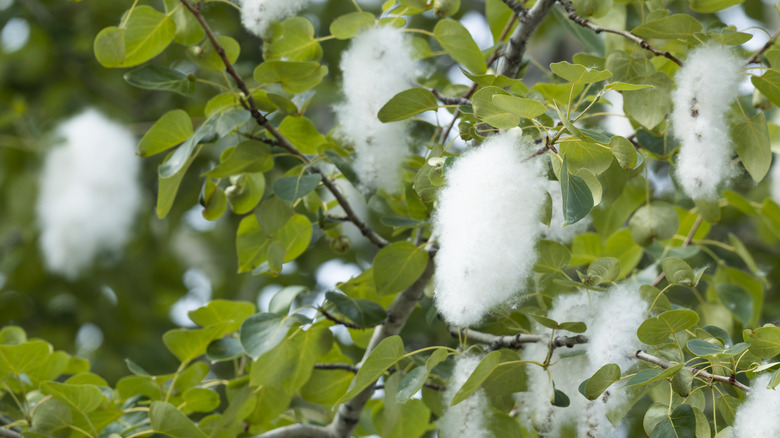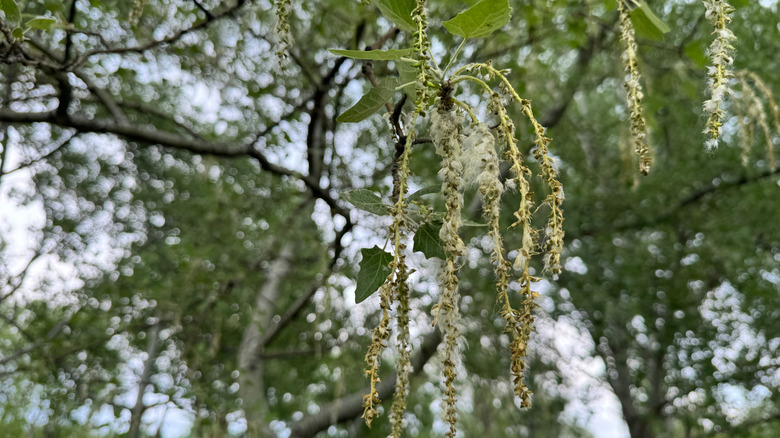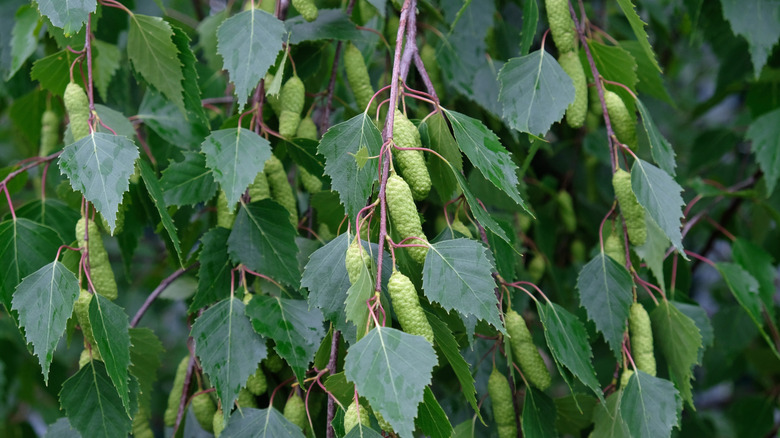Nest-Building Plants Every Hummingbird Lover Should Have In Their Garden
Even if you don't consider birdwatching to be your favorite hobby, there's no denying that observing hummingbirds flit around your yard can provide endless entertainment. Not only do they have remarkable feeding habits, but these fascinating creatures are also skilled architects when building their nests. Using materials like moss, spider silk, and fluffy plant down, female hummingbirds expertly craft these tiny structures that blend into the branches. By incorporating plants that provide the materials they need to begin constructing, feathered friends are even more likely to view your yard as a top choice to raise their young.
Creating a bird-friendly garden at home is a rewarding way to enjoy watching hummingbirds while giving them everything they require to thrive. These tiny fliers choose nesting sites that meet their basic needs for building and survival. They look for small deciduous trees or dense shrubs that provide sturdy branches and good cover, ideally near where food sources are readily available. Some flowers that attract hummingbirds, like clematis, will offer both nest-building materials and a steady supply of nectar, while other plants come with a sturdy nesting site. Determining the most common species in your area can help you choose the best varieties. Understanding their nesting season and habits allows you to select plants that bloom when colorful visitors are most likely to stop by your yard. Here are some of the top nest-building plants to consider.
Cinnamon fern
Female hummingbirds work tirelessly to create small, cup-shaped nests that are insulated, soft, and stretchy enough to expand as their little ones grow. After constructing a sturdy base out of twigs and other plant parts, they search for plush materials, like the fibers from cinnamon fern (Osmundastrum Cinnamomum) fronds, to add a soft lining. The fuzzy inner area gently cradles the eggs while keeping them warm. Because hummingbirds have evolved with native plants, they're more likely to search for species they've seen growing in nature. Cinnamon fern grows all over North America, making this familiar plant more attractive to hummingbirds than non-native species. Additionally, it's a host plant to several insects, like caterpillars, which provide the necessary protein for hummingbirds.
Hardy in zones 4-10, cinnamon fern is one of the best native plants for landscaping in almost any region in North America. Its lush foliage not only looks beautiful in nearly any area of your garden, but it also provides the perfect spot for hummingbirds to get protection from predators or the elements. Their distinctive fronds appear in spring as fuzzy fiddleheads before turning a brownish shade, looking similar to cinnamon sticks. This award-winning plant is low-maintenance, growing up to six feet tall and three feet wide once established. Although it prefers dappled shade, cinnamon fern can grow in full sun if it's frequently in standing water. Choose a soil blend that's slightly acidic, humusy, fertile, and well-draining, but do not let it dry out between waterings.
Thistle
Although thistle is often considered a weed, don't be so quick to pull out the herbicide. While some species of thistle are non-native and considered invasive, several varieties naturally grow in North America. Field thistle (Cirsium discolor), for example, is a native species that is nectar-rich and beneficial for several animals, including hummingbirds. Thistle is a hummingbird favorite because it's waterproof, helps insulate the eggs, and is easy for them to work with. Additionally, these small birds require multiple meals each hour to survive, sometimes stopping for nectar or insects every 10 minutes. Because they feed so much, they must live near food sources like thistle when raising young. So, leave some native varieties in your yard to provide a valuable resource for hummingbirds.
There are several varieties of thistle, and you may already have some growing in your backyard. Field thistle commonly grows in the eastern half of the United States, while species like wavyleaf thistle (Cirsium undulatum) are more common in western states. Easily grown, both thistles prefer full sun and can grow in many well-drained soil types. Most of these flowers are relatively drought-tolerant and rarely need supplemental watering, though it depends on the species. Although some thistles die after flowering, they will self-seed, allowing new plants to pop up year after year.
Dandelion
Native to Eurasia, dandelions (Taraxacum officinale) were brought to North America in the 1600s by settlers to cultivate for food and medicinal purposes, though they're now one of the most common weeds in our yards. Although they're considered invasive in Alaska and Oregon, dandelions don't pose much of an ecological threat in most areas. Alternatively, hummingbirds love using these tiny flowers to build their nests. If your childhood included making wishes on their white seedheads, you already know how light and fuzzy they are. Dandelion down makes the perfect lining to keep a hummingbird mom's nest insulated and waterproof while being gentle on the hatchling's delicate skin.
If you already have dandelions popping up in your yard, you likely realize encouraging them to stay isn't much of an issue. Low maintenance is an understatement, as they grow in zones 3-9 and can tolerate full sun to full shade conditions. They aren't picky about soil either, though they prefer fertile, well-drained soil. To grow dandelions in your yard, sow the seeds 1/4 an inch below the soil six weeks before the expected last frost. Dandelions thrive when the soil is moist, so give them a good watering when the top two inches of soil is dry.
Milkweed
Despite the name, milkweed (Asclepias) isn't a weed but a large genus with over 100 native species growing in the United States. It's one of the best plants to help pollinators, as it's the only flower monarch butterflies use as a host plant. Although hummingbirds sometimes drink nectar from milkweed, they're more likely to grab one of the many insects attracted to it. The real benefit this species provides comes in late summer when it produces seedpods. When the time comes for seeds to spread, the floss inside expands until the pod opens. When this happens, hummingbirds take the soft fibers and use them to line their nests.
Common milkweed (Asclepias syriaca) is likely what comes to mind when thinking of the milkweed plant. This sweetly scented flowering perennial is hardy in zones 3-9 and is extremely easy to grow. Tolerant of poor soils, it thrives when planted in an area that receives at least eight hours of sunlight. Once established, it's drought tolerant and can withstand dry soils, so rainwater is typically enough to keep it happy. Each plant grows up to four feet tall and about a foot wide, though it spreads through underground rhizomes and can quickly take over the area if not managed.
Clematis
With around 380 varieties in the clematis genus, there are plenty of showy blooms to choose from. Abundant in nectar, these vines are the perfect addition if you want to attract pollinators. Not only do hummingbirds enjoy drinking from clematis blooms, but they also use them to build their nests. Once the flowering season comes to an end, feathery seedheads begin taking their place. Hummingbirds use the spent flowers and the soft seedheads to construct the inner layer. The plush material makes a cozy and secure environment, keeping their eggs and hatchlings safe and comfortable as they grow.
Proper care for clematis plants depends on the cultivar you choose to grow in your garden. Clematis have a diverse range of growth habits, with some climbing or spreading and others developing more like shrubs. Generally, they grow in zones 4-10 and thrive when grown in full sun, though some varieties can tolerate partial shade. They prefer a neutral to slightly alkaline soil blend. Although they like well-drained soil, it's important not to let it dry out. However, they won't be as thirsty once they're more established.
Honeysuckle
Honeysuckle (Lonicera) is another hummingbird favorite that produces seedheads that house fluffy fibers they can use them for nest-building. Additionally, this flowering climbing vine, specifically trumpet honeysuckle (Lonicera sempervirens), is one of the best flowers to attract hummingbirds to your yard. The tubular shape of the blooms allows hummingbirds to insert their long bills deep into the flower, where they can access the nectar. It's also a host to several caterpillars, so they can fuel up on protein for themselves and their babies. Female hummingbirds need flowers like trumpet honeysuckle close to their nest so they can not only eat but also feed their nestlings.
Growing up to 15 feet tall and six feet wide, trumpet honeysuckle is a low-maintenance vine that looks stunning when climbing a trellis or fence. This plant blooms best in full sun and comes in vibrant shades of red, orange, and yellow. Although it can tolerate dry conditions, it thrives when the soil is moist but well-drained. Lonicera sempervirens isn't too particular about the pH level, though it likes average soils. While it may be favorable to hummingbirds, deer tend to steer clear of it.
Pasque flower
With their large, vibrant blooms and bright yellow centers filled with stamens, pasque flowers (Pulsatilla vulgaris) look like something out of a fairy tale. These whimsical plants are covered in tiny hairs, giving them a soft, frosty appearance. Blooming in early-mid spring, pasque flowers are some of the earliest perennials to bloom, putting out flowers while others are still waking up. Each hummingbird species lays their eggs at different times of the year, so the foliage's delicate fibers can provide nesting materials during months other plants may not be able to. Additionally, they produce feather seed heads when their flowers fade, giving female hummingbirds even more cushiony padding for nest-building.
This pollinator magnet thrives in a sunny area of your yard and looks right at home in cottage-style or rock gardens. Choose a site with fertile, humusy, and well-drained soils, but give them plenty of water during hotter months. Available in purple and blue shades, pasque flower is hardy in zones 4-8, making it suitable for several climates. The fuzzy, leathery foliage isn't palatable to rabbits, so it may help deter them from nibbling other plants in your garden.
Blanket flower
If you add blanket flower (Gaillardia) to your garden, you can expect to have a yard buzzing with pollinators. Once the nectar-rich flowers die off, they immediately produce soft seed pods that mother hummingbirds can use to line their nests. These daisy-like flowers will not only serve as a nutrient-dense drink for hummingbirds but also provide them with plenty of insects and anthropods to snack on and feed their nestlings. A reliable protein source near the nest is vital for these small birds, as roughly 80% of their diet consists of bugs. Blanket flowers have a long blooming period, making them a nutritional hub for hummingbirds from summer to fall.
As a common wildflower, blanket flower is native to several regions of North America, predominantly in the western and northern areas. Hardy in zones 3-10, there is almost certainly a species within this genus that will thrive in your garden. This tough plant can tolerate poor soils and can survive periods of drought once established. All it asks is for is well-drained soil and an area where it can get plenty of sun.
Lamb's ear
Aptly named, lamb's ear (Stachys byzantina) features thick, distinctive foliage densely covered in soft, silky hairs, giving it its unique appearance. Hummingbirds love this groundcover for several reasons, including using the fibers from its fuzzy leaves to line their nests. While the unique foliage is the true star of the show, this plant also displays flowers that attract pollinating insects. Although their blooms aren't a hummingbird favorite, they can stop by and snag a caterpillar to bring back to their tiny nestlings.
Lamb's ear is a low-maintenance plant that can thrive in partial shade, though full sun encourages more vigorous growth of its decorative foliage. Once established, it's drought-tolerant and handles dry conditions well, making it ideal for xeriscaping. As an ornamental foliage plant, lamb's ear provides visual interest throughout the seasons. With the right conditions, it can grow to be about 8 inches tall and have a spread of up to 36 inches. Additionally, lamb's ear is deer and rabbit-resistant, making it useful for deterring larger pests from your garden.
Pussy willow
If you want to encourage hummingbirds to nest in your yard, planting a pussy willow (Salix discolor) is one of the best ways to do so. Growing as a shrub or small tree, it produces fuzzy catkins that appear sometime in spring, making it well-liked by hummingbirds, who appreciate the abundance of material they can use to pad their nests. As their eggs hatch, the momma bird won't have to go far to find food for her tiny nestlings either, as pussy willows host a plethora of insects for her to choose from, like flies and ants.
Reaching heights of 20 feet tall, pussy willows are some of the earliest spring bloomers. It's one of the few plants that can not only tolerate incredibly moist soil but can even thrive in poorly drained soil. Although it'll happily grow in nearly any soil type, it prefers fertile and well-drained conditions. The main requirement for optimal growth is providing your tree with full sun.
Cottonwoods
If your yard has enough space for a 100-foot-tall tree, cottonwood trees, namely the Eastern cottonwood (Populus deltoides), are eye-catching plants that provide nearly everything a hummingbird needs to thrive. These cloud-like trees fill with a cottony fluff in late spring or early summer, giving hummingbirds access to plenty of nest-lining material. Cottonwood trees may also have lichen that they can use to camouflage the nest from predators. Additionally, the tall deciduous trees have plenty of durable branches and good cover, making them a considerable nesting site. Hummingbirds also prefer trees living near a water source, and cottonwoods thrive living beside bodies of water.
Cottonwood trees require ample space not only for their outward growth but also for their extensive root system to expand. Although they're tolerant of shade, they grow best when planted in an area with full sun. There isn't much these hardy trees can't withstand, including a wide range of soils, drought, and occasional flooding. Native to several states in the U.S., you can add this stunning tree to your yard in zones 3-9.
Poplars
Poplar trees are another group within the Populus genus that hummingbirds turn to when constructing nests. Species like black poplar (Populus nigra) and balsam poplar (Populus balsamifera) are a couple of notable options where our small flying friends can find catkins for nest-building materials. Ruby-throated hummingbirds will also choose a spot within the branches of these trees to build their nests, selecting an area about 10-40 feet above the ground. While they're available in different heights, all poplars are fast-growing, allowing you to help hummingbirds more quickly than if you opt for slow-growing species.
Because there are several types of poplar trees, each will have different care requirements. Generally, these trees are hardy in zones 3-9 and require full sun to thrive. Poplars are another type of tree that naturally live in wetlands, which can aid in their growth while providing hummingbirds quick access to water. However, if your poplar tree isn't growing near a river or lake, it'll need a weekly shower to stay healthy. Although they don't require regular feedings, applying fertilizer to the planting hole can give your tree a nutrient boost to grow.
Other catkin bearing trees that are good for hummingbirds
Although we've touched on a few alreadt, there are several types of catkin-bearing trees that hummingbirds will be grateful to see in your yard. Species like beech, mulberry, witch hazel, alder, birch, and maple produce plenty of fuzzy materials perfect for nest-building. Witch hazel is especially beneficial as it provides a protective nesting site and rich nectar for hummingbirds in cooler months when most flowers aren't in bloom. That said, many of these, including beech, birch, and maple, are top choices for female hummingbirds to build their nests. Meanwhile, mulberry buzzes with protein-rich insects, especially when it bears its fruit in summer.
With so many types of trees and shrubs abundant in catkins, you can easily find a species that best suits your climate and garden. If space allows, consider planting a few to provide hummingbirds with a more diverse selection. Once you decide on a type or two that best benefits your local hummingbird species, follow the recommended care guidelines to maintain a healthy plant. Prune your plants carefully to avoid disturbing your small visitors. Pay attention to hummingbird activity near the branches, and only do heavy trims when you notice lessened activity.
